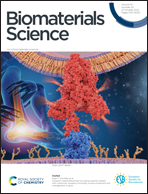Dual-responsive and NIR-driven free radical nanoamplifier with glutathione depletion for enhanced tumor-specific photothermal/thermodynamic/chemodynamic synergistic Therapy†
Abstract
The efficacy of free radical-based therapeutic strategies is severely hindered by nonspecific accumulation, premature release and glutathione (GSH) scavenging effects. Herein, a tumor microenvironment-responsive MPDA/AIPH@Cu-TA@HA (abbreviated as MACTH) nanoplatform was constructed by coating Cu2+ and tannic acid (TA) on the surface of azo initiator (AIPH)-loaded mesoporous polydopamine (MPDA) nanoparticles and further modifying them with hyaluronic acid (HA) to achieve tumor-specific photothermal/thermodynamic/chemodynamic synergistic therapy (PTT/TDT/CDT). Once accumulated and internalized into cancer cells through CD44 receptor-mediated active targeting and endocytosis, the HA shell of MACTH would be preliminarily degraded by hyaluronidase (HAase) to expose the Cu-TA metal-phenolic networks, which would further dissociate in response to an acidic lysosomal environment, leading to HAase/pH dual-responsive release of Cu2+ and AIPH. On the one hand, the released Cu2+ could deplete the overexpressed GSH via redox reactions and produce Cu+, which in turn catalyzes endogenous H2O2 into highly cytotoxic hydroxyl radicals (˙OH) for CDT. On the other hand, the local hyperthermia generated by MACTH under 808 nm laser irradiation could not only augment CDT efficacy through accelerating the Cu+-mediated Fenton-like reaction, but also trigger the decomposition of AIPH to produce biotoxic alkyl radicals (˙R) for TDT. The consumption of GSH and accumulation of oxygen-independent free radicals (˙OH/˙R) synergistically amplified intracellular oxidative stress, resulting in substantial apoptotic cell death and significant tumor growth inhibition. Collectively, this study provides a promising paradigm for customizing stimuli-responsive free radical-based nanoplatforms to achieve accurate and efficacious cancer treatment.



 Please wait while we load your content...
Please wait while we load your content...